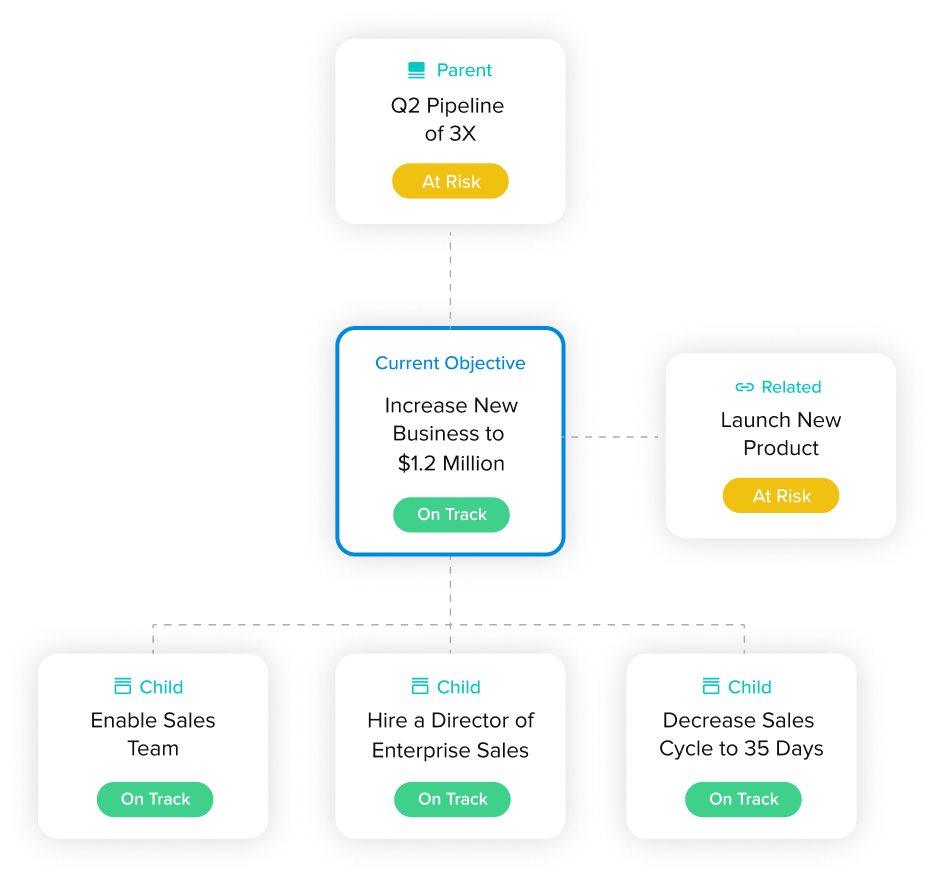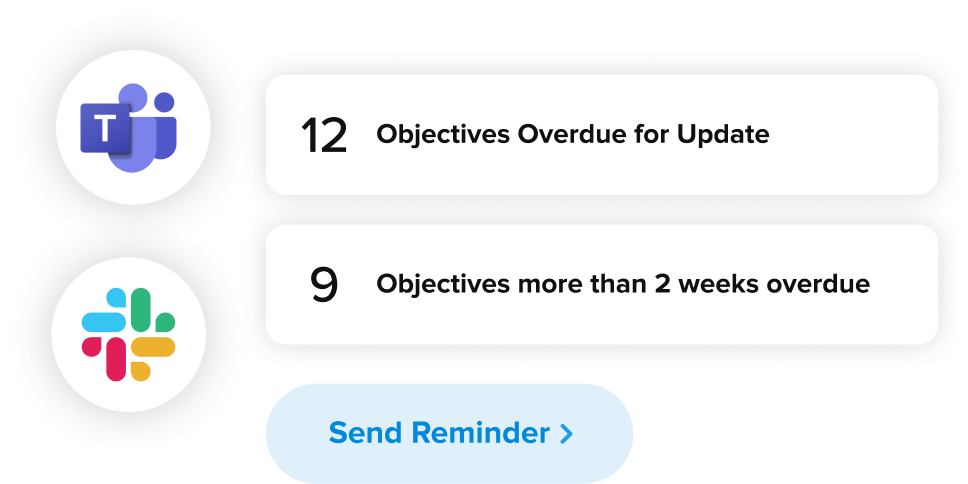Whether you're managing a singular marketing campaign or an entire business, you need to set goals and milestones to see success. There are many ways to set these goals, and what's right for you might not work for someone else. S.M.A.R.T. goals are great, and specific metrics are important, but you might want more of an overarching strategy to explain why those numbers matter. This is where the OKR vs KPI debate comes in.
Objective and Key Result (OKR) is a framework for setting business goals and tying them to determined results. This method was originally created by Andy Grove at Intel, and while it was made popular at Google, this method has been adapted for hundreds of other companies across the globe. The OKR Google designed uses a rating scale from 0.0 to 1.0 and is color coded to measure how well they are doing.
Key Performance Indicators (KPIs) are very narrow and often result from completing the S.M.A.R.T. goals framework. However, at larger companies where not everyone is involved in the goal setting process, it can be difficult to explain why a specific goal is important. This is especially true if one department feels that the goal does not apply to their work. Several KPIs working together helps grow a business better than everyone working in their own bubble.
When it comes to using the Key Results vs KPI method, the choice that's right for your organization is entirely dependent on your company. There are several factors you can use to determine which method will work the best. No matter what, though, you can bet that your new strategy will completely change how your business sets, interprets, and meets goals. Before you decide whether to use an OKR or KPI, take a few minutes to learn more about each method by reading the information below. Then, weigh the pros and cons of each option for your organization and even consider a hybrid approach if you find them both to be equally compelling.
KPI Meaning
KPI stands for Key Performance Indicator. It is a specific measurement that helps you track progress and ensure growth. For example, it's hard to know when you've reached your goal if your goal is simply "gain more Twitter followers". You could gain just one more follower and declare yourself successful, but it's not likely that one more follower will lead to the increase in profits you're looking for. However, if your goal is "gain 10,000 Twitter followers", it's easier to know when you've succeeded and how those 10,000 followers will relate to business growth.
The KPI meaning will be different for every organization, but they frequently have something to do with building an audience, making more sales, and reducing operating costs. Your KPIs will often be decided based on your company’s goals and initiatives. The KPI vs OKR debate is long-running, but it's not always a debate of one or the other. Both strategies can often be used by an organization. Having a number to attach to a more vague or large goal allows you to break the goal down into something that feels achievable.
Although there are many types of key performance indicators, a focused strategy will tend to work better than one with a lot of KPIs. So, what are the 5 key performance indicators we recommend?
- The first KPI is Quantitative. This means it provides you with a specific number that can be measured, such as time spent on a task or profits made.
- The second KPI is Qualitative. This is more descriptive, and may be backed up by Quantitative KPIs. Having a positive online reputation is a good example of a qualitative indicator and it can be backed up by quantitative indicators such as 5-star reviews and testimonials.
- The third is Leading. These are numbers that support the hypothesis of business growth, such as an increase in leads, even though they don't directly equate to growth.
- The fourth KPI is Lagging. These numbers cover a specific time period to measure if a certain initiative worked well or not. For example, the amount of revenue generated in quarter two compared to quarter one. You can then use these numbers to inform your goals for quarter three and beyond.
- The fifth KPI we'll mention is Input. This relates to the resources, such as labor and equipment costs, that you use during the business process. They help you see how efficient (or not) your process is.
OKR Meaning
OKR stands for Objective and Key Results. This is a two-pronged approach because your major objectives will be tied to key results. The OKR methodology is more like a framework for your business goals, versus a list of checkpoints to achieve. Essentially, the objective is the "why" behind the quantitative goals. When you're wondering "Why do we need to write 10 blog posts per month?" you can answer with your objective "to become a thought leader in our industry."
The OKR meaning for your organization will start with an objective that, on its own, will likely seem vague or overly ambitious. To prevent your team from feeling overwhelmed by these objectives, you'll back them up with key results. When you've reached the desired results, you'll know that you've met your objectives. These key results are the quantitative measurements that you use to support your qualitative objectives.
When developing an OKR framework, it's important to sit down with the leaders of each department and build it together. Getting their input will be the best way to ensure they are accepting of the goals and willing to work hard for them. It is typically recommended to set between three and five objectives. This allows you to work on several departments at once without feeling like you're changing the entire organization. Within each objective, you'll want to set three to five key results. This ensures a well-rounded approach since having just one indicator is not necessarily indicative of achieving the desired objective.
The combination of objective and key results tends to work better for larger organizations because it is more robust than a list of key performance indicators. However, that doesn't mean that KPIs aren't also a successful strategy. In fact, KPIs are often more accepted by large teams when used in conjunction with OKRs.
OKR Examples
There are many OKR examples on the internet, but the ones that are right for your business will be completely unique. When setting your own OKRs, you'll need to consider your current status, company size, annual revenue, and available resources. Although becoming the thought leader in your industry is a great goal, if you've just opened your business last month, it might be hard to achieve in the near future. Setting smaller OKRs is a great place to start. Here are a few objectives and key results examples for various types of businesses.
New company OKR examples are typically focused on establishing a strong hold in the market. Your objective might be related to developing an audience. If so, your key results will typically involve increasing social media followers, gaining newsletter subscribers, and writing guest posts for blogs in your niche.
Small company OKR examples tend to focus on growth and profit. An objective that says to increase revenue by 30% will likely be followed with key results that involve gaining new leads, turning those leads into new customers, and increasing the rate of lead conversion.
Large company OKR examples are usually centered around leadership and dominance. If your objective is to become a market leader, your key results will likely have high revenue goals, increased staff size, and attendance as a speaker at trade shows and conferences.
No matter the size or age of your organization, growth is a very common goal and an OKR strategy can help you achieve that. OKR examples for growth can be adapted for new, small, and large companies. Making your first million in revenue is great, but if you've been around for awhile, you might be looking at the billions instead. Regardless, the OKR framework can be molded to suit your company no matter what stage of growth you're at.
OKR and KPI Together
There are many companies that use an OKR and KPI together. For example, the Google OKR helps various teams plan their work, track their progress, and stay focused on the company's overarching goals. The KPIs can then be used to inform leaders about the status of specific metrics within a certain department that are important to monitor, but not tied to a specific objective. This framework has been adapted and used at many other large companies including Twitter, LinkedIn, and Zynga.
The most effective strategy, for a business in any industry, is to utilize OKR and KPI together. By setting objectives and following up with key results and performance indicators, it's easier to get your entire team to cooperate. When the guidelines for success are clearly marked, there can be no question of strong performance.
There may initially be some confusion on the difference between key results and key performance indicators among your team members. The important thing to remember is that the key results are outcomes while key performance indicators are measurements. Though they may have similar wording when building your strategy, they are a bit different. Searching for some real OKR examples and how they work with KPIs can help you better define the strategy for your specific team.
The beauty of this combined approach is that it can be modified to grow with you. As you accomplish your objectives, you can reframe your goals and reach even higher. You'll already have the framework in place and your team will understand how their performance will be measured. This makes using OKR and KPI together an easy choice for any organization.




























